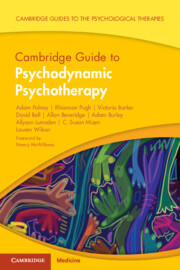Book contents
- Cambridge Guide to Psychodynamic Psychotherapy
- Cambridge Guides to the Psychological Therapies
- Reviews
- Cambridge Guide to Psychodynamic Psychotherapy
- Copyright page
- Dedication
- Contents
- Foreword
- Preface
- A Note from the Series Editor
- Acknowledgements
- Part 1: An Overview of the Model
- Part 2: The Model of Psychodynamic Psychotherapy into Practice
- Chapter 5 Framing a Psychodynamic Space
- Chapter 6 The Goals of Psychodynamic Psychotherapy
- Chapter 7 Psychodynamic Psychotherapy Technique
- Chapter 8 The Overall Structure of Psychodynamic Therapy
- Chapter 9 Psychological Assessment and Formulation in Psychodynamic Psychotherapy
- Chapter 10 Some Reflections on the Supervisory Process
- Part 3: Application for Mental Health Presentations
- Part 4: Application of Psychodynamic Psychotherapy in Different Populations and in Different Settings
- Glossary of Terms
- Index
- References
Chapter 7 - Psychodynamic Psychotherapy Technique
from Part 2: - The Model of Psychodynamic Psychotherapy into Practice
Published online by Cambridge University Press: 25 August 2023
- Cambridge Guide to Psychodynamic Psychotherapy
- Cambridge Guides to the Psychological Therapies
- Reviews
- Cambridge Guide to Psychodynamic Psychotherapy
- Copyright page
- Dedication
- Contents
- Foreword
- Preface
- A Note from the Series Editor
- Acknowledgements
- Part 1: An Overview of the Model
- Part 2: The Model of Psychodynamic Psychotherapy into Practice
- Chapter 5 Framing a Psychodynamic Space
- Chapter 6 The Goals of Psychodynamic Psychotherapy
- Chapter 7 Psychodynamic Psychotherapy Technique
- Chapter 8 The Overall Structure of Psychodynamic Therapy
- Chapter 9 Psychological Assessment and Formulation in Psychodynamic Psychotherapy
- Chapter 10 Some Reflections on the Supervisory Process
- Part 3: Application for Mental Health Presentations
- Part 4: Application of Psychodynamic Psychotherapy in Different Populations and in Different Settings
- Glossary of Terms
- Index
- References
Summary
This chapter describes specific techniques employed in modern day psychodynamic psychotherapy. It commences with a brief outline of the core psychodynamic attitude consisting of relative restraint, ‘anonymity’, and ‘neutrality’ along with helpful tips for the psychotherapist at the start of their career. It then goes on to a section on the importance of unconscious communication which includes a brief instruction on dream interpretation. This is followed by a detailed description on the use of transference and countertransference to elicit relevant object relations; this section includes how to manage ruptures in therapy. There is a description of the spectrum of interventions and techniques used in psychodynamic psychotherapy ranging from the more supportive end of the spectrum through to the more expressive. The chapter concludes with the process of working through and managing resistance. Throughout there are suggestions for how to couch interventions when working with a patient and also clinical vignettes to illustrate key techniques.
Keywords
- Type
- Chapter
- Information
- Cambridge Guide to Psychodynamic Psychotherapy , pp. 98 - 127Publisher: Cambridge University PressPrint publication year: 2023

